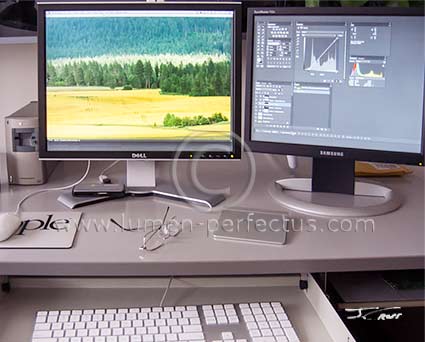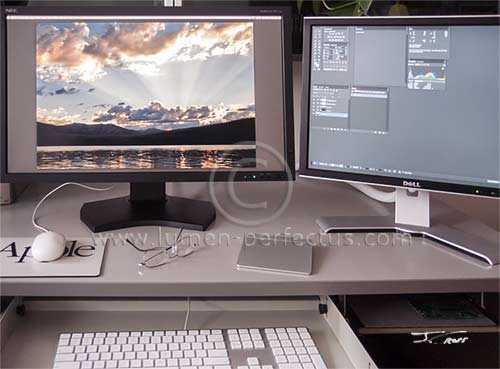www.lumen-perfectus.com
A New View
“And now for a change of screenery.” Max Headroom
A lot of stuff is needed to properly “do” modern fine art photography. Years ago I engaged in a discussion in which the pros and cons of digital photography were compared to those of what was then considered traditional photography, i.e. film and the wet darkroom. As you'd expect, that debate had no clear winner. But film or digital, if you take your photography from image capture to final print, you'll need some square footage to contain the equipment, consumables, framing, the inventory you produce, and even books and other publications.
Coming to the digital party perhaps a bit late, I shot my last roll of film early in 2007. I'd been scanning slides and working with the digital result for several years. Image capture with a DSLR replaced one layer of that workflow with another; it didn't feel completely alien. I had in place a computer, the usual collection of peripherals, and image editing software.
As with the image capture “half” of digital photography, the post-processing half, including printing, requires an investment in equipment. The big pieces are important: computer(s), monitor(s), printer(s), and the software to make it all work. The smaller gear, while perhaps less necessary, can make the workflow smoother, faster, and more enjoyable: drawing tablets, other input devices, abundant file storage, and utility software.
Among the most important pieces of computer gear for the photographer are, in my opinion, the monitor and the tools used to profile, or calibrate it so it displays accurate color and luminosity (brightness).
The Color-corrected View

The Dell 20-inch (left) and the 17-inch Samsung, in action. Displayed image © 2013, Jay Cross. All rights reserved.
I first used my pictures only for display on the Web. I had a typical Windows computer and a 16 inch CRT monitor. A couple of years later I added a 19 inch monitor. The pair consumed the entire top of my desk and caused it to groan under the weight. The CRTs heated the room nicely in winter and added to my cooling bills in summer, but I loved the arrangement. I filled the larger screen with the image editing window, putting all the tool windows and other clutter on the smaller monitor.
I used ColorEyes Display software and an X-rite DTP-94 colorimeter to calibrate the monitors. Neither of the inexpensive CRTs calibrated as well as I'd have liked, but they were adequate, about what one would expect in their price range.
I eventually replaced the smaller CRT with a 17 inch Samsung LCD monitor, and in 2006 replaced the larger CRT with a 20 inch Dell Ultrasharp LCD. The Dell seemed large, and calibrated reasonably well. The Samsung didn't, but as the secondary monitor, was less important. I only need its brightness to be similar to the primary monitor so it wouldn't distract, and that was easy enough to accomplish. I should note that neither of these monitors had LED backlighting, largely unheard of at the time.
I happily used that monitor pair until March of 2014. During that time I upgraded the calibration software to ColorEyes Display Pro (CEDP), which had a number of nice improvements over the original, greater stability not least among them. I continued to use the DTP-94 colorimeter.
Putting it on Paper
I bought my first large-format printer in 2007. As described in The Paper Chase, I spent a year mastering the machine and the process, developing a workflow that allowed me to consistently produce good prints. I replaced that printer in 2011 and have continued to learn, and to refine my process and workflow.
I'd been very happy with the quality of the prints, whether of my own work or of the clientele I'd developed, but getting a good print-to-monitor match nearly always required some effort. I felt this effort should be unnecessary; if the monitor calibrated properly, one had high-quality printing profiles, and all else in the stream worked as it should, no tweaking of the image would be necessary when I wanted to make a print. My prints were nearly always close, often close enough. But only rarely were they an excellent match to the monitor.
NEC MultiSync
With that issue in mind, and wanting a larger, wide-gamut display, I began the pre-purchase research I always do when a large (for me) expenditure is likely. In late summer 2013 I looked at the available wide-gamut monitors and determined that something in NEC's “PA” series would be my best choice. These monitors hadn't been updated in some time. They still used CCFL (florescent) backlighting rather than LED. I delayed the purchase, waiting for newer technology and its potential benefits.
NEC's new line of LED-backlit PA-series monitors, announced late in 2013, began shipping early in 2014. As expected, the prices were high. Given the specialty nature of these monitors, I didn't expect a price drop.

The NEC 27-inch (left) and the Dell 20-inch, in action. Displayed image © 2012, Jay Cross. All rights reserved.
My DTP-94 colorimeter, once rated among the best, performs poorly with wide-gamut LED-backlit monitors. I'd have to budget for a replacement colorimeter, most of which come in a package that includes the software to “run” it. I'm happy with the CEDP software, and it supports a number of newer colorimeters; I expected I'd continue to use that rather than whatever came with the new colorimeter.
NEC offers a package that includes the monitor, a NEC-branded X-rite EyeOne Pro colorimeter, and NEC's SpectraViewII calibration software. Since I needed a new colorimeter anyway, this seemed the best package for me. I decided on the 27 inch model with the colorimeter and software. If you can't be good, be lucky: a few weeks ago several of the resellers of this package showed slightly reduced prices on their Web sites. My NEC PA272W-BK-SV arrived in mid-March.
Size Matters; Accuracy Matters More
The NEC is now my primary monitor, while the 20-inch Dell is the secondary. Native resolutions are 2560x1440 pixels, and 1600x1200 pixels, respectively. The combination makes for a lot of screen space, a nearly 80% increase over the Dell + Samsung pair, yet the two monitors fit nicely on my desk.
Calibrating the NEC with its colorimeter and SpectraViewII software is very easy and fast, even if the maximum number of profile steps (color patches) is used. And the result is excellent. I've made three prints since installing the NEC. All are near-perfect matches to the Photoshop soft-proofed version on the monitor. One is a black and white image; the tones in the print match those on the display quite well.
Unfortunately, the NEC-customized EyeOne Pro colorimeter can't be used with any software other than SynchMasterII, and SynchMasterII can't be used with any monitor except NEC's. That means I'll continue to use CEDP and the DTP-94 to calibrate the Dell LCD. That's not a bad thing.
It's said you can't be too rich, too thin, or have too many closets. To that I'd add, “or have too much monitor real estate.”
March, 2014
All products and brand names mentioned are trademarks or registered trademarks of their respective owners.